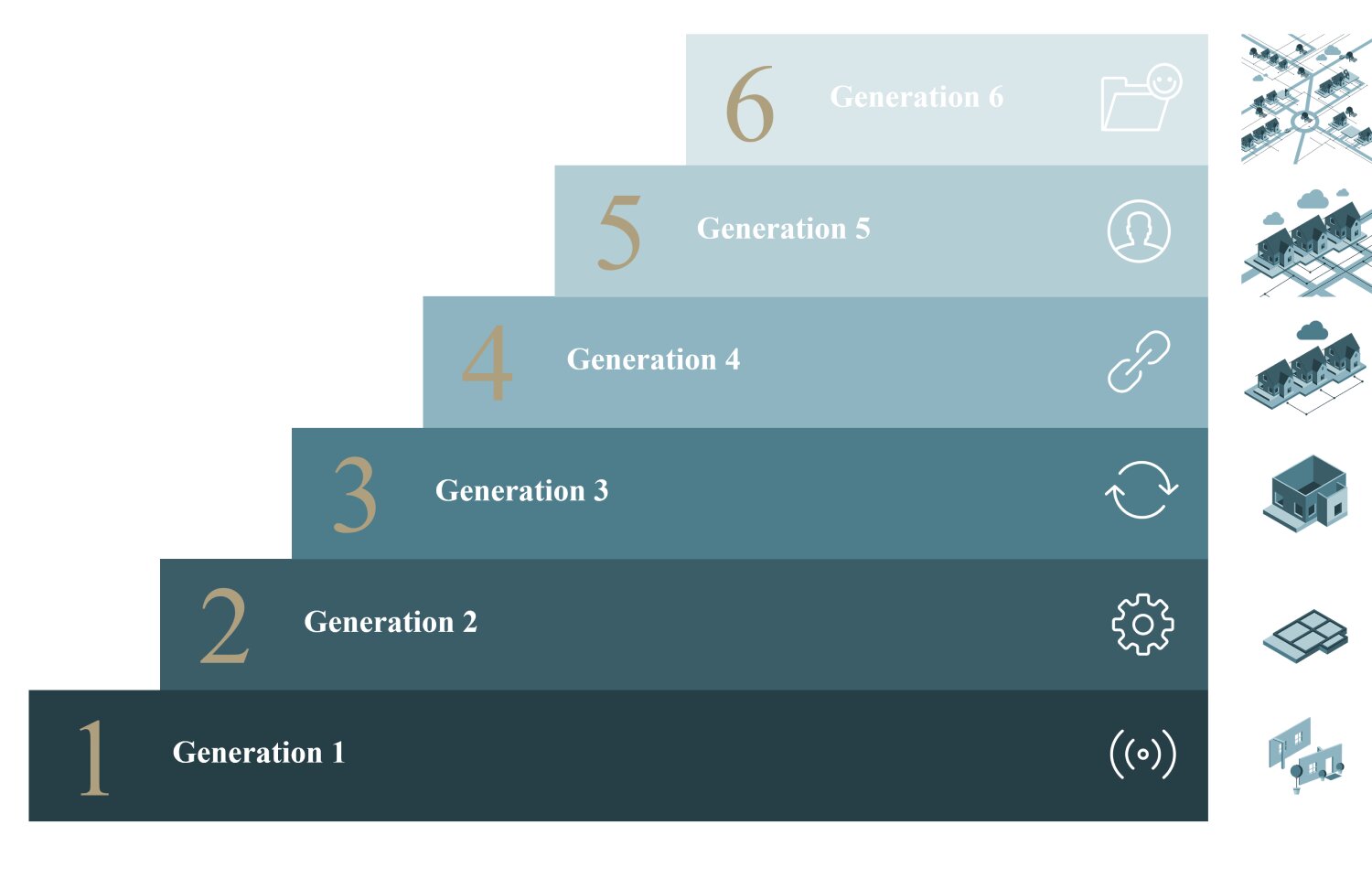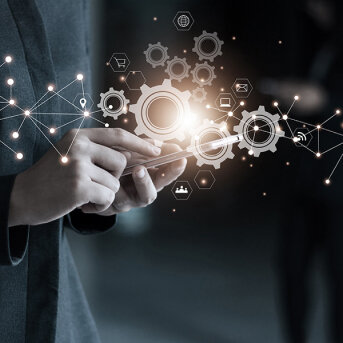
The 6 Generations of Digital Maturity is based on Pernille Kræmmergaard's research over the past 25+ years and our practical experience from companies and organizations. The framework has evolved from its original two generations. In line with digital and technological developments, Generation 3 was added in the late 2000s, Generation 4 in 2016, Generation 5 in 2019 and most recently Generation 6 in 2024.
The figure to the right shows the 6 generations. At the bottom step, Generation 1, it's mostly about powering workflows and processes. At the top step, Generation 6, organizations and companies are working to develop and offer transparent and traceable products and services to end-customers and business partners, while remaining personalized and proactive, and enabling customers to “bring and own” their own data.
The generations in the figure are depicted as a staircase to illustrate that each new step builds on the previous one. At each step there are new things to learn and new opportunities and challenges. At the same time, an organization will typically be on several steps simultaneously.

Where are you today?
And where do you want to be?
It may sound simple, but you can only succeed if you have an overview of your current digital maturity and clear strategic ambitions and goals. This framework supports that effort.
We recommend using DI2X mapping tools to measure your current digital maturity and identify your focus areas now and in the coming years.
Apply the Digital Maturity Tool to uncover the 6 generations of digital maturity in your organization.
If you are curious if our Tools are relevant for you and your organization, you can order a free access and try the Tool.
Each generation represents a distinct management practice and digital mindset, and each generation places different demands on management.
A digital mindset is the ability to lead and demonstrate an understanding of the strategic, technological, organizational and leadership changes that are necessary at all times to contribute constructively to an organization's continued digital maturation.
An organization that has made it all the way to Generation 6 and has the organizational capabilities that this interim top step requires - and few do - will still need some of what it has learned in Generations 1, 2, 3, 4 and 5. But the digital mindset will be different.
You can map your own digital mindset with the DI2X Digital Mindset Profile mapping Tool.
If you are curious if our tools are relevant for you and your organization, you can order a free access and try the Tool.
In Generation 1, the goal is to save money and resources.
The focus is on saving resources by letting customers and citizens serve themselves and by digitizing analog documents and manual processes.
In doing so, individual employees and departments introduce their own digitized solutions.
The lack of coordination means frequent errors and a lack of overview, as well as an inadequate decision-making basis.

In Generation 2, the goal is to do things right. Processes and systems, and thus the work of the entire company or organization, must be more efficient, better coordinated and integrated.
Local solutions are replaced with centralized systems that take care of core processes throughout the company.
At the same time, it provides the opportunity to take internal data and use it to create an overview of activities and processes to see where the organization can become more efficient.
Leaders are given greater responsibility for IT systems and data and how to implement the central systems to realize the expected benefits.

In Generation 3, the goal is to develop new products and services for customers or deliver solutions in a better way.
There will be a need to develop a digital mindset and an awareness of the transformative potential of technologies and the need to mature strategy, organization and leadership.
The focus will increasingly be on the customer experience and perspective and the organization will start to think from the outside-in. At the same time, technologies are invited into your development space and used curiously to develop new solutions.
Leaders will need to develop new competencies to focus on and also measure the progress of digital maturation and be mindful of making the transformative changes meaningful to employees.

In Generation 4, the goal is to fulfill the underlying needs of the end-customer in a coherent way together with others.
A longer horizon is needed with a strategic emphasis on visions rather than strategies. This raises questions like; what will we be doing for a living in 10 years? And what do we need to be really good at, and what do others we work with need to be really good at?
The focal point for the development of products, processes and services will be value for the end-customer. To create that value, we need to collaborate in ecosystems of equal partners who create and share value together. This makes data quality and secure data processing business-critical, while data itself gains business value.
Leaders will play a driving role in driving innovative business models and fostering strategically important external collaborations in the ecosystem.

In generation 5, the goal is personalized and proactive services using data.
In this generation, technology and professionalism merge as technology empowers employees to create proactive and personalized solutions for end-customers. This creates new professional profiles and the need to rethink the job boundaries.
Data is the driving force behind both innovation and decisions. That's why it's crucial to be in control of data, deciding what data should and shouldn't be used for and where metrics add value.
At the same time, data and cyber security becomes business-critical. A lack of security is not only costly in lost production and reputation. It can also be difficult to restore credibility in relation to customers' and partners' data afterwards, and thus take the business forward.
As a leader, it's important to be clear on the purpose of the technologies your company uses and ensure that employees and the organization understand both the possibilities and limitations.


In Generation 6, the aim is to develop and offer both transparent and traceable products and services to end-customers and partners, still personalized and proactive, and enable the customer to "bring and own" their own data.
There will be a focus on propriety, including ensuring transparency and traceability in everything the company does.
Customer ownership of their own data is made possible through decentralized data wallets and blockchain, and it is also made possible for customers to decide which and how much data they want to include in the service they receive and the underlying advanced data processing.
Collaboration is characterized not only by ecosystems, but also by working in smaller eco-communities with a common goal and values that go beyond economic benefits.
At the same time, this generation has an eye for managing multiple bottom lines, including ESG reporting, and ensuring compliance with not only existing requirements and external expectations, but also future ones.
Leaders need to understand and use sustainability and decency as a strategic driver and differentiator.

What you have just seen is a brief introduction to the 6 Generations of Digital Maturity, based on Pernille Kræmmergaard's academic research and practical experience.
The framework is described more in depth in the book “Mind the Gap. Digital Maturation - Your leadership responsibility”.
You can read more about the first five generations in the book "Digital Maturity - Strategy, Technology, Organization and Leadership in 5 Generations".
The book is intended as a user guide for managers at all levels.
Buy Mind the Gap
Buy Digital Maturity
It might also be relevant for you to use our Online Tools to measure your current digital maturity.
